Holly Thompson's Blog, page 10
November 30, 2017
Gyōza
It's #PoetryFriday!
This coming week I'll be presenting a webinar for NCTAsia on the Kamakura setting, characters and bullying situations in my verse novel Falling Into the Dragon's Mouth (Henry Holt)--in conjunction with the NCTAsia Book Group on Japan Through Children's Literature: Kamakura, A Seaside Town.
This NCTAsia Falling Into the Dragon's Mouth webinar is for one hour on Dec. 5, 7-8 pm EST (that's Dec. 6, 9-10 am Japan time). Sign up is free; see details here. Please share with teachers, librarians, and middle school/middle grade literature readers!
Here is the Falling Into the Dragon's Mouth book description from the 2016 NCTAsia Freeman Book Awards page:
"Told through the eyes of a middle school American boy who is living in Japan, students have a compelling account of issues ever present in society today and how to deal with them: bullying, feeling isolated, not fitting in, cross-cultural understanding, and how to survive teenage years. It is also a window into Japanese culture and school life, while exploring emotions and issues that all teenagers are constantly facing when “friend groups” dominate and exclusion is visible and difficult, especially when moving across the cultural pathways."
And see this recent review on Tales from Two Cities: "Just Different."
So for Poetry Friday, I thought I'd share an excerpt from the novel.
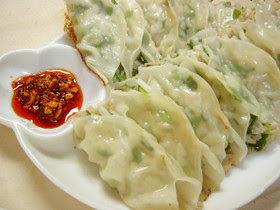 https://cookpad.com/recipe/1044121
https://cookpad.com/recipe/1044121
In this scene, from the chapter "Gyōza," narrator and main character Jason picks up his younger sister Cora from the after-school center on a Wednesday, the day her grade at the local Japanese school is dismissed earlier than Jason's. Lines indicate page breaks.
___
when I arrive at the after-school centerCora is waiting in the entryway with her shoes on before I’ve even signed her out
she’s quiet till we reach the hillthen she says don’t tell Mom
tell Mom what? I ask
that I hate the kids there! she saysthen adds they call me gyōza
gyōza?—dumpling? I say then laughwhy gyōza?
her eyes start tearingas she holds out her armpointing at the veins
I’m like gyōza—they can see throughmy skin to the stuff inside
___
I tell her at least it’s a nameof something that tastes goodand that they’re just not usedto different types of skin
I tell herwe’ll have our adventurein the park across the town linethe one past the water towerwith the good swings
I tell herwe’ll take cardboard for slidingcardboard boxes that willfly on the dry grassjust like sleds
and Cora wipes her armacross her eyes
okay she says
___
we walk to the park on the hillbeyond the water towerwith a folded cardboard box each
and we run up and slide downthe wide brown grassy hilluntil our hair iswet from sweat
then after a while Cora makes a friendand they slide togetherthen go off to play house under a tree
and I lie back on the cardboardstare at the veins on the insides of my armsand laugh
I never thought of usas gyōza
___
Above excerpted poems © Holly Thompson, All Rights Reserved
Find Poetry Friday posts by many kidlit poets at the Kidlitosphere Poetry Friday Round-up, hosted this week by A Year of Reading.
<!-- /* Font Definitions */ @font-face {font-family:"MS 明朝"; mso-font-charset:128; mso-generic-font-family:auto; mso-font-pitch:variable; mso-font-signature:-536870145 1791491579 134217746 0 131231 0;} @font-face {font-family:Century; panose-1:2 4 6 4 5 5 5 2 3 4; mso-font-charset:0; mso-generic-font-family:auto; mso-font-pitch:variable; mso-font-signature:647 0 0 0 159 0;} @font-face {font-family:"Cambria Math"; panose-1:2 4 5 3 5 4 6 3 2 4; mso-font-charset:0; mso-generic-font-family:auto; mso-font-pitch:variable; mso-font-signature:-536870145 1107305727 0 0 415 0;} @font-face {font-family:Cambria; panose-1:2 4 5 3 5 4 6 3 2 4; mso-font-charset:0; mso-generic-font-family:auto; mso-font-pitch:variable; mso-font-signature:-536870145 1073743103 0 0 415 0;} /* Style Definitions */ p.MsoNormal, li.MsoNormal, div.MsoNormal {mso-style-unhide:no; mso-style-qformat:yes; mso-style-parent:""; margin:0cm; margin-bottom:.0001pt; text-align:justify; text-justify:inter-ideograph; mso-pagination:none; font-size:10.5pt; mso-bidi-font-size:12.0pt; font-family:Century; mso-fareast-font-family:"MS 明朝"; mso-bidi-font-family:"Times New Roman"; mso-font-kerning:1.0pt;} .MsoChpDefault {mso-style-type:export-only; mso-default-props:yes; font-family:Cambria; mso-ascii-font-family:Cambria; mso-fareast-font-family:"MS 明朝"; mso-hansi-font-family:Cambria; mso-fareast-language:EN-US;} @page WordSection1 {size:612.0pt 792.0pt; margin:72.0pt 72.0pt 72.0pt 72.0pt; mso-header-margin:36.0pt; mso-footer-margin:36.0pt; mso-paper-source:0;} div.WordSection1 {page:WordSection1;} </style> --></div>
This coming week I'll be presenting a webinar for NCTAsia on the Kamakura setting, characters and bullying situations in my verse novel Falling Into the Dragon's Mouth (Henry Holt)--in conjunction with the NCTAsia Book Group on Japan Through Children's Literature: Kamakura, A Seaside Town.
This NCTAsia Falling Into the Dragon's Mouth webinar is for one hour on Dec. 5, 7-8 pm EST (that's Dec. 6, 9-10 am Japan time). Sign up is free; see details here. Please share with teachers, librarians, and middle school/middle grade literature readers!
Here is the Falling Into the Dragon's Mouth book description from the 2016 NCTAsia Freeman Book Awards page:
"Told through the eyes of a middle school American boy who is living in Japan, students have a compelling account of issues ever present in society today and how to deal with them: bullying, feeling isolated, not fitting in, cross-cultural understanding, and how to survive teenage years. It is also a window into Japanese culture and school life, while exploring emotions and issues that all teenagers are constantly facing when “friend groups” dominate and exclusion is visible and difficult, especially when moving across the cultural pathways."
And see this recent review on Tales from Two Cities: "Just Different."
So for Poetry Friday, I thought I'd share an excerpt from the novel.
 https://cookpad.com/recipe/1044121
https://cookpad.com/recipe/1044121In this scene, from the chapter "Gyōza," narrator and main character Jason picks up his younger sister Cora from the after-school center on a Wednesday, the day her grade at the local Japanese school is dismissed earlier than Jason's. Lines indicate page breaks.
___
when I arrive at the after-school centerCora is waiting in the entryway with her shoes on before I’ve even signed her out
she’s quiet till we reach the hillthen she says don’t tell Mom
tell Mom what? I ask
that I hate the kids there! she saysthen adds they call me gyōza
gyōza?—dumpling? I say then laughwhy gyōza?
her eyes start tearingas she holds out her armpointing at the veins
I’m like gyōza—they can see throughmy skin to the stuff inside
___
I tell her at least it’s a nameof something that tastes goodand that they’re just not usedto different types of skin
I tell herwe’ll have our adventurein the park across the town linethe one past the water towerwith the good swings
I tell herwe’ll take cardboard for slidingcardboard boxes that willfly on the dry grassjust like sleds
and Cora wipes her armacross her eyes
okay she says
___
we walk to the park on the hillbeyond the water towerwith a folded cardboard box each
and we run up and slide downthe wide brown grassy hilluntil our hair iswet from sweat
then after a while Cora makes a friendand they slide togetherthen go off to play house under a tree
and I lie back on the cardboardstare at the veins on the insides of my armsand laugh
I never thought of usas gyōza
___
Above excerpted poems © Holly Thompson, All Rights Reserved
Find Poetry Friday posts by many kidlit poets at the Kidlitosphere Poetry Friday Round-up, hosted this week by A Year of Reading.
<!-- /* Font Definitions */ @font-face {font-family:"MS 明朝"; mso-font-charset:128; mso-generic-font-family:auto; mso-font-pitch:variable; mso-font-signature:-536870145 1791491579 134217746 0 131231 0;} @font-face {font-family:Century; panose-1:2 4 6 4 5 5 5 2 3 4; mso-font-charset:0; mso-generic-font-family:auto; mso-font-pitch:variable; mso-font-signature:647 0 0 0 159 0;} @font-face {font-family:"Cambria Math"; panose-1:2 4 5 3 5 4 6 3 2 4; mso-font-charset:0; mso-generic-font-family:auto; mso-font-pitch:variable; mso-font-signature:-536870145 1107305727 0 0 415 0;} @font-face {font-family:Cambria; panose-1:2 4 5 3 5 4 6 3 2 4; mso-font-charset:0; mso-generic-font-family:auto; mso-font-pitch:variable; mso-font-signature:-536870145 1073743103 0 0 415 0;} /* Style Definitions */ p.MsoNormal, li.MsoNormal, div.MsoNormal {mso-style-unhide:no; mso-style-qformat:yes; mso-style-parent:""; margin:0cm; margin-bottom:.0001pt; text-align:justify; text-justify:inter-ideograph; mso-pagination:none; font-size:10.5pt; mso-bidi-font-size:12.0pt; font-family:Century; mso-fareast-font-family:"MS 明朝"; mso-bidi-font-family:"Times New Roman"; mso-font-kerning:1.0pt;} .MsoChpDefault {mso-style-type:export-only; mso-default-props:yes; font-family:Cambria; mso-ascii-font-family:Cambria; mso-fareast-font-family:"MS 明朝"; mso-hansi-font-family:Cambria; mso-fareast-language:EN-US;} @page WordSection1 {size:612.0pt 792.0pt; margin:72.0pt 72.0pt 72.0pt 72.0pt; mso-header-margin:36.0pt; mso-footer-margin:36.0pt; mso-paper-source:0;} div.WordSection1 {page:WordSection1;} </style> --></div>
Published on November 30, 2017 18:56
November 23, 2017
Insinuation Poems
The Japanese language is full of vagueness. Directness is possible, but often it's avoided.
I wish I'd kept track of the myriad indirect ways in which people in the neighborhood, in the community, at work have given me advice over the years. Often a method of saying one thing to imply something else is stealthily employed. As a second language speaker, I'm often so focused on the statement I hear that I'm a beat or two late cluing in to the insinuation.
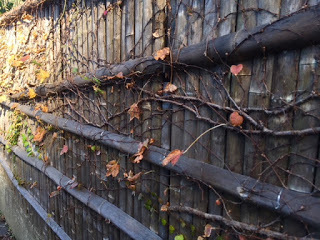
So for #PoetryFriday here are some insinuation poems based on some recent moments in which I was a beat or two behind grasping the implied message hidden behind the speaker's actual words.
Perhaps you'll craft some to share, too!
Window Talk
to hint that I’m lateopening the rain shuttersa neighbor stops meafter I set out the trash to compliment our curtains
Naked Knees
summery weatherI opt for a knee-length skirt over bare legs thatthe nurse drapes with a blanket insisting they must be cold
Street Cleaning
How windy it was!our neighbor exclaims oflast night’s storm. Leaves are everywhere!Yes! I say, then shift my plans and get the broom
Above poems © Holly Thompson, All Rights Reserved
I wish I'd kept track of the myriad indirect ways in which people in the neighborhood, in the community, at work have given me advice over the years. Often a method of saying one thing to imply something else is stealthily employed. As a second language speaker, I'm often so focused on the statement I hear that I'm a beat or two late cluing in to the insinuation.

So for #PoetryFriday here are some insinuation poems based on some recent moments in which I was a beat or two behind grasping the implied message hidden behind the speaker's actual words.
Perhaps you'll craft some to share, too!
Window Talk
to hint that I’m lateopening the rain shuttersa neighbor stops meafter I set out the trash to compliment our curtains
Naked Knees
summery weatherI opt for a knee-length skirt over bare legs thatthe nurse drapes with a blanket insisting they must be cold
Street Cleaning
How windy it was!our neighbor exclaims oflast night’s storm. Leaves are everywhere!Yes! I say, then shift my plans and get the broom
Above poems © Holly Thompson, All Rights Reserved
Published on November 23, 2017 19:30
November 16, 2017
Tribute to Morgan Gibson
In late October, poet Morgan Gibson died (1929-2017), and last weekend I attended a small gathering in Kamakura for sharing memories, sharing poems by Morgan and by his translator/scholar wife Keiko Matsui Gibson, and segueing to Bach on cello performed by his son Christopher Gibson. It was a beautiful gathering, followed by lunch and more conversation, and we walked home via back roads, stopping to quietly visit Chojuji, a Buddhist temple only recently opened to the public, to stare at moss and stone gardens. It seemed we were still in that time-space cloud that Morgan seemed to inhabit, even when he was present with us. Morgan seemed to share a joyous wonder for the world, and his immersion in that pondering wonder led to poems I will always treasure.
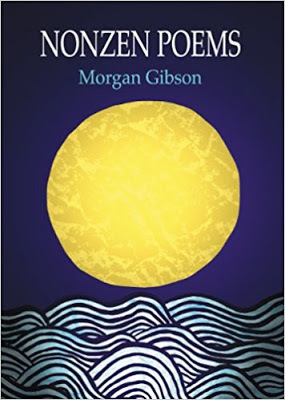
Many of Morgan's poems are perfect for sharing with young writers. One poem read at the memorial gathering "I Am How I Breathe," from his collection Nonzen Poems (review) published by Printed Matter Press, would be a perfect poem for teens to attempt to "trace"--as explained in Rachel Richardson's "Learning Image and Description": "A trace is an act of imitation in which you choose your own subject (locale, weather, objects, etc.) and then apply it to the master poem, in effect rewriting the poem with different objects."
Here is the opening of that poem:
I AM HOW I BREATHE
I am how I breathe beech smoke in rain
leaves eyeing me at dusk rustling me asleep
eyes harboring a sea
And here is an excerpt of another favorite of mine from Nonzen Poems
CHINESE TEAPOT
When you stare at words
they gape like fish on a pier.
Like fish by a pier
poems hide among rocks.
Among rocks they float
like seaweed in our dreams.
Another one from Nonzen Poems is "The Moon in Milk." Here is the opening:
THE MOON IN MILK
The moon in milk
hunts for you.
*
Where is a ray
for your eye?
*
Who is as bright
as the moon
and as clouded?
*
The moon
hunts hiding
moonstones.
There are many more great poems to share in Morgan's collection Lusterless Wanderer and Other Poems, (also published by Printed Matter Press) including "No One the One," "Poet of Snow" and "The Mailman."
See also Morgan's poem "Zazen in the Temple of Choice" in Poetry Kanto.
And his essay collection Among Buddhas in Japan.

Thank you to Morgan Gibson for leaving us these poem gems to carry forward as we wander.

Many of Morgan's poems are perfect for sharing with young writers. One poem read at the memorial gathering "I Am How I Breathe," from his collection Nonzen Poems (review) published by Printed Matter Press, would be a perfect poem for teens to attempt to "trace"--as explained in Rachel Richardson's "Learning Image and Description": "A trace is an act of imitation in which you choose your own subject (locale, weather, objects, etc.) and then apply it to the master poem, in effect rewriting the poem with different objects."
Here is the opening of that poem:
I AM HOW I BREATHE
I am how I breathe beech smoke in rain
leaves eyeing me at dusk rustling me asleep
eyes harboring a sea
And here is an excerpt of another favorite of mine from Nonzen Poems
CHINESE TEAPOT
When you stare at words
they gape like fish on a pier.
Like fish by a pier
poems hide among rocks.
Among rocks they float
like seaweed in our dreams.
Another one from Nonzen Poems is "The Moon in Milk." Here is the opening:
THE MOON IN MILK
The moon in milk
hunts for you.
*
Where is a ray
for your eye?
*
Who is as bright
as the moon
and as clouded?
*
The moon
hunts hiding
moonstones.
There are many more great poems to share in Morgan's collection Lusterless Wanderer and Other Poems, (also published by Printed Matter Press) including "No One the One," "Poet of Snow" and "The Mailman."
See also Morgan's poem "Zazen in the Temple of Choice" in Poetry Kanto.
And his essay collection Among Buddhas in Japan.

Thank you to Morgan Gibson for leaving us these poem gems to carry forward as we wander.
Published on November 16, 2017 18:39
November 9, 2017
Morning Run Confession
It's #PoetryFriday!
And here is my short poem movie "Morning Run Confession" about a tiny moment when a flying object came in over the sea waves during my routine morning run.
This week's Poetry Friday Roundup is hosted at Jama's Alphabet Soup and it involves donuts! Have a look if you dare, and check out all the poems in the roundup.
And here is my short poem movie "Morning Run Confession" about a tiny moment when a flying object came in over the sea waves during my routine morning run.
This week's Poetry Friday Roundup is hosted at Jama's Alphabet Soup and it involves donuts! Have a look if you dare, and check out all the poems in the roundup.
Published on November 09, 2017 20:29
October 27, 2017
Typhoon Task
It's #PoetryFriday, and this past week in Kamakura, Japan, we had a major typhoon. Sometimes people who are inland from the coast just a short distance have no idea what the coast has endured or how a storm has impacted a fishing community.
The Shonan coast was hit hard by Typhoon 21. On the morning after the typhoon, I took a long walk along the coast and was stunned by the damage--beach erosion, debris everywhere, fishing huts destroyed, infrastructure damage... It will take a long while for our shore to recover.
Two days after the typhoon, I went out for a run in more rain--me in my pink rain jacket and running gear--and one of the fishing women on the beach tending to cleaning up the beach looked up and waved at me with a big grin.
So I made an iMovie poem: "Typhoon Task." It's short. You might need to watch it twice.
Here it is:
For more Kidlitosphere #PoetryFriday posts, see the roundup here.
The Shonan coast was hit hard by Typhoon 21. On the morning after the typhoon, I took a long walk along the coast and was stunned by the damage--beach erosion, debris everywhere, fishing huts destroyed, infrastructure damage... It will take a long while for our shore to recover.
Two days after the typhoon, I went out for a run in more rain--me in my pink rain jacket and running gear--and one of the fishing women on the beach tending to cleaning up the beach looked up and waved at me with a big grin.
So I made an iMovie poem: "Typhoon Task." It's short. You might need to watch it twice.
Here it is:
For more Kidlitosphere #PoetryFriday posts, see the roundup here.
Published on October 27, 2017 06:07
September 12, 2017
NCTAsia Programs!
I'm happy to have two of my books featured in an upcoming National Consortium for Teaching About Asia (NCTAsia) Fall 2017 online book group and I'm looking forward to participating in a concluding webinar event.
Japan Through Children's Literature: Kamakura, A Seaside Town will focus on two of my books: my picture book The Wakame Gatherers (Lee & Low/Shen's) and my verse novel Falling Into the Dragon's Mouth (Henry Holt Books for Young Readers). This NCTAsia online book group will be offered through three asynchronous modules during October and November.
Register by September 25!

And here are the details from the brochure:
*******
Overview:
A short trip from Tokyo, Kamakura provides a vivid window into Japan’s past and present. As Japan’s military capital from 1185-1333, the city was the site of an emerging warrior governance and culture that continued to shape Japan for almost 700 years. Today, Kamakura is a center of aquaculture, and its hills, dotted with Buddhist and Shinto institutions, are a modernera retreat for Japanese as well as ex-pats. This online course will explore Kamakura (and Japan) through two books—The Wakame Gatherers and Falling into the Dragon’s Mouth—both by children’s author Holly Thompson, a resident of Kamakura. We will discuss the history and geography of Kamakura, traditional and contemporary culture, and the lives of children in Japan today. The course will also consider the two books’ literary forms and techniques, social studies connections, and cross-curricular classroom applications.
Online Format:
The book group will be offered through three asynchronous modules. The book group opens with online introductions, October 6-12, 2017. The three modules run: October 13-26; October 27-November 9; and November 10-28. In early December 2017, a concluding webinar with author Holly Thompson (sponsored by NCTA at the Five College Center for East Asian Studies) and submission of a final paper and evaluation will complete the program.
Eligibility and Expectations:
Open to elementary and middle school teachers nationwide. Admission is selective and priority will be given to contract teachers whose curriculum incorporates Japan and teachers who have not previously taken an online course with the University of Colorado’s NCTA or TEA programs. Participants are responsible for acquiring the two books in advance of the book group start date. Teachers are expected to participate fully in all three module discussions and the webinar with author, submit a three- to four-page Classroom Implementation Plan (CIP) describing ways to use the books in their teaching, and complete an evaluation.
Participation is free, with the following benefits for full participation:
• Certificate of Completion for 15 contact hours.
• $50 recognition award upon satisfactory completion of the course.
Apply online at www.colorado.edu/ptea/Japan-Child-Lit.... Application closes September 25, 2017, or when book group is full. Course limit: 20 eligible teachers. For more information, e-mail Catherine Ishida, ishida@colorado.edu.
*******
I will also be presenting a concluding webinar, Falling into the Dragon's Mouth, with Author Holly Thompson on December 5, 2017, 7:00-8:00 p.m. (EST). Anyone is welcome to participate in this webinar—you do not need to be a member of the online book group. But register by September 25!
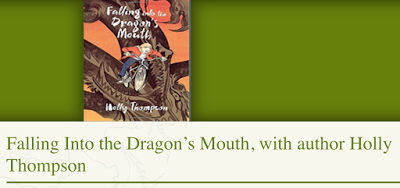
These are just two of the many programs offered by NCTAsia. Check out all of the NCTAsia offerings--webinars, book groups, courses, study tours and institutes at NCTAsia.org.
Japan Through Children's Literature: Kamakura, A Seaside Town will focus on two of my books: my picture book The Wakame Gatherers (Lee & Low/Shen's) and my verse novel Falling Into the Dragon's Mouth (Henry Holt Books for Young Readers). This NCTAsia online book group will be offered through three asynchronous modules during October and November.
Register by September 25!

And here are the details from the brochure:
*******
Overview:
A short trip from Tokyo, Kamakura provides a vivid window into Japan’s past and present. As Japan’s military capital from 1185-1333, the city was the site of an emerging warrior governance and culture that continued to shape Japan for almost 700 years. Today, Kamakura is a center of aquaculture, and its hills, dotted with Buddhist and Shinto institutions, are a modernera retreat for Japanese as well as ex-pats. This online course will explore Kamakura (and Japan) through two books—The Wakame Gatherers and Falling into the Dragon’s Mouth—both by children’s author Holly Thompson, a resident of Kamakura. We will discuss the history and geography of Kamakura, traditional and contemporary culture, and the lives of children in Japan today. The course will also consider the two books’ literary forms and techniques, social studies connections, and cross-curricular classroom applications.
Online Format:
The book group will be offered through three asynchronous modules. The book group opens with online introductions, October 6-12, 2017. The three modules run: October 13-26; October 27-November 9; and November 10-28. In early December 2017, a concluding webinar with author Holly Thompson (sponsored by NCTA at the Five College Center for East Asian Studies) and submission of a final paper and evaluation will complete the program.
Eligibility and Expectations:
Open to elementary and middle school teachers nationwide. Admission is selective and priority will be given to contract teachers whose curriculum incorporates Japan and teachers who have not previously taken an online course with the University of Colorado’s NCTA or TEA programs. Participants are responsible for acquiring the two books in advance of the book group start date. Teachers are expected to participate fully in all three module discussions and the webinar with author, submit a three- to four-page Classroom Implementation Plan (CIP) describing ways to use the books in their teaching, and complete an evaluation.
Participation is free, with the following benefits for full participation:
• Certificate of Completion for 15 contact hours.
• $50 recognition award upon satisfactory completion of the course.
Apply online at www.colorado.edu/ptea/Japan-Child-Lit.... Application closes September 25, 2017, or when book group is full. Course limit: 20 eligible teachers. For more information, e-mail Catherine Ishida, ishida@colorado.edu.
*******
I will also be presenting a concluding webinar, Falling into the Dragon's Mouth, with Author Holly Thompson on December 5, 2017, 7:00-8:00 p.m. (EST). Anyone is welcome to participate in this webinar—you do not need to be a member of the online book group. But register by September 25!

These are just two of the many programs offered by NCTAsia. Check out all of the NCTAsia offerings--webinars, book groups, courses, study tours and institutes at NCTAsia.org.
Published on September 12, 2017 09:09
August 5, 2017
72nd Anniversary
Today, August 6 at 8:15 a.m. in Japan, was the 72nd anniversary of the atomic bombing of Hiroshima.
 October 1945, photo by Shigeo Hayashi of the building that became the Hiroshima Peace Memorial or Genbaku Dome (source: wikimediacommons)
October 1945, photo by Shigeo Hayashi of the building that became the Hiroshima Peace Memorial or Genbaku Dome (source: wikimediacommons)
On Sunday, August 6, throughout the world, there will be peace gatherings, candlelight vigils and memorial ceremonies.
In the Boston area, where I'm based this summer, on Sunday evening the Hiroshima-Nagasaki Peace Memorial will be held at 6:30 p.m., at St. Paul's Episcopal Church in Brookline.
There will also be a remembrance and peace picnic at 11:45 on the Cambridge Common--Remembering Hiroshima and Nagasaki: Celebrating the U.N. Treaty Prohibiting Nuclear Weapons.
And a commemoration of the attacks on Hiroshima and Nagasaki at the Watertown Square and Dock--Remembering Hiroshima and Nagasaki--from 6:30 p.m. will include the launching of floating lanterns.
See what is happening in your area. Or create your own remembrance event.
And be sure to read the story of children survivors in Hiroshima: Running with the Cosmos Flowers: The Children of Hiroshima (Pelican Publishing).
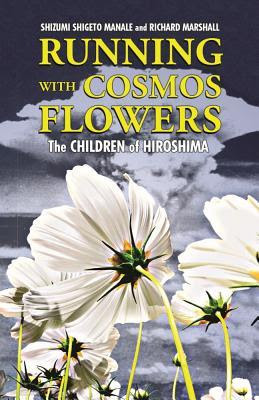
And read John Hersey's Hiroshima, now online in The New Yorker, where it was originally published in 1946.
May we always remember, and may the world one day be free of nuclear weapons.
 October 1945, photo by Shigeo Hayashi of the building that became the Hiroshima Peace Memorial or Genbaku Dome (source: wikimediacommons)
October 1945, photo by Shigeo Hayashi of the building that became the Hiroshima Peace Memorial or Genbaku Dome (source: wikimediacommons)On Sunday, August 6, throughout the world, there will be peace gatherings, candlelight vigils and memorial ceremonies.
In the Boston area, where I'm based this summer, on Sunday evening the Hiroshima-Nagasaki Peace Memorial will be held at 6:30 p.m., at St. Paul's Episcopal Church in Brookline.
There will also be a remembrance and peace picnic at 11:45 on the Cambridge Common--Remembering Hiroshima and Nagasaki: Celebrating the U.N. Treaty Prohibiting Nuclear Weapons.
And a commemoration of the attacks on Hiroshima and Nagasaki at the Watertown Square and Dock--Remembering Hiroshima and Nagasaki--from 6:30 p.m. will include the launching of floating lanterns.
See what is happening in your area. Or create your own remembrance event.
And be sure to read the story of children survivors in Hiroshima: Running with the Cosmos Flowers: The Children of Hiroshima (Pelican Publishing).

And read John Hersey's Hiroshima, now online in The New Yorker, where it was originally published in 1946.
May we always remember, and may the world one day be free of nuclear weapons.
Published on August 05, 2017 20:03
July 5, 2017
Norman Dorsen--A Tribute
When I was in my mid-twenties, after living in Japan for three years, I moved to New York City to attend the graduate Creative Writing Program at New York University. I could not afford tuition, so on a tip from the program's secretary, I deferred admission for one semester and applied for a full-time job at NYU, so that after three months I’d be eligible for tuition reimbursement. Because I was a writer, I aced the typing test at the personnel office and was interviewed immediately for a job in the NYU School of Law as an administrative assistant to a prominent constitutional law professor.
“He’s demanding,” my interviewer cautioned.
No problem, I said.
“You’ll need to be extremely attentive to details. He expects careful, professional work.”
I’m up to the task, I said.
“You may not always agree with his perspective.”
Meaning . . . ?
“He’s president of the ACLU.”
I’ll take the job, I said.
And so I was hired to be administrative assistant to the late Norman Dorsen, whose recent obituary in the New York Times reveals his brilliant, steadfast mind and his contributions to the protections of civil rights and civil liberties.
 New York Times obituary for Norman Dorsen
New York Times obituary for Norman Dorsen How lucky I was. When I was hired to work for Professor Dorsen, I knew next to nothing about the ACLU and zero about constitutional law. I'd been focused on biology, music, literature, Japanese. I entered a new world at the law school.
For two years, I worked 9-5 for Normen Dorsen, and during my lunch hours studied, researched, wrote my world lit papers and short stories in the library, and attended my graduate courses at night.
Norman Dorsen was demanding and particular in his work habits. He typed his correspondence furiously in the mornings, marked up the pages with extensive edits, handed them to me to decipher and retype, marked them up again, and turned the over to me to retype what was hopefully, the final version. Afternoons were focused on his larger projects, lectures, ACLU work, Arthur Garfield Hays Civil Liberties Program tasks, research, and writing. These were the late 1980s--pre-email. He was reluctant to part with his typewriter, but thankfully he approved a computer for me.
While administrative work may seem mundane, how fortunate I was to learn from Norman Dorsen’s work ethic, his powerful legal mind, his constant advocacy for human rights and his steady streams of careful correspondence. Through such close work with his words and by daily attention to the minutiae of his mind, I was gifted with a model for how to be diligent, dogged and precise, how to steer clear of cynicism, how to stay focused, and how to keep vigilant and guard against the erosion of civil liberties. As administrative work goes, it was a great job, and one I would have held for longer, except that I was offered the chance to teach creative writing courses to undergrads at NYU—and I moved on.
Norman Dorsen’s filing systems and editing approaches are apparent in my own writing systems, and in my own daily work routines, I often find that his sharp editing pen, his marking method, and his words of advice to me as a young writer come fresh to mind. I shall always be grateful for my two years serving Professor Dorsen and the Arthur Garfield Hays Civil Liberties Program at the NYU School of Law. I was privileged to learn from him, and I extend my condolences to the Dorsen family.
Published on July 05, 2017 04:58
June 29, 2017
College App Essays!
For the past two weeks I've been teaching a summer program course at Yokohama International School--Essay Writing for College Applications. I had ten students each week, with most taking the course for the full two weeks.
I LOVE teaching this intensive writing course in which students spend 10 days focused on reading, discussing and drafting personal essays.
And this was one diligent group. Everyone on time to class every day. Each assignment completed with gusto. No dip in energy midway through the second week. Everyone powered through and the growth was incredible, the resulting essays daring and original. Oh, colleges and universities, you have some powerful stories and students coming your way.
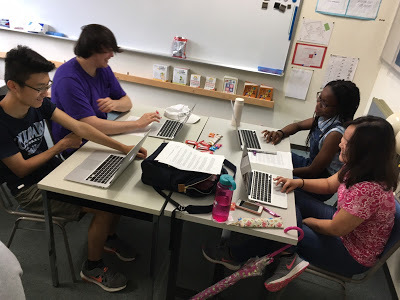
All told, this amazing class wrote 55 essays plus 20 revisions.
And I held 50 one-to-one writing consultations.
Whew! Time for summer break.
I LOVE teaching this intensive writing course in which students spend 10 days focused on reading, discussing and drafting personal essays.
And this was one diligent group. Everyone on time to class every day. Each assignment completed with gusto. No dip in energy midway through the second week. Everyone powered through and the growth was incredible, the resulting essays daring and original. Oh, colleges and universities, you have some powerful stories and students coming your way.

All told, this amazing class wrote 55 essays plus 20 revisions.
And I held 50 one-to-one writing consultations.
Whew! Time for summer break.
Published on June 29, 2017 21:57
June 28, 2017
Celebrating Japan in MA
Here are two upcoming events that I'm excited to be a part of this summer. Both will take place in the Five College area of Western Massachusetts. Join me at Hampshire College for my Author Talk on Monday, July 10, as part of Doors to the World Summer Institute: East Asia and at Jones Library in Amherst for the Tanabata celebration on Tuesday, July 11. Both events are free and open to the public.
Hope to see you there!
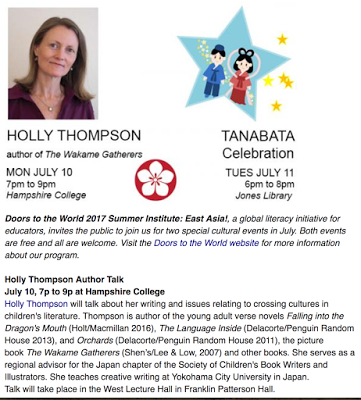
Here is the info from the Five College Consortium:
 For immediate release:
For immediate release:Two Five College events aim to please families and inform educatorsTwo upcoming events organized by the Five College Schools Partnership Program will celebrate Japanese fiction for young people.
Children’s/Young Adult book author Holly Thompson at Hampshire CollegeJuly 10, 7 p.m. West Lecture Hall in Franklin Patterson Hall On Monday, July 10, Holly Thompson will talk about her writing and issues relating to crossing cultures in children's literature. Thompson is author of the young adult verse novels Falling into the Dragon's Mouth (Holt/Macmillan 2016), The Language Inside (Delacorte/Penguin Random House 2013), and Orchards (Delacorte/Penguin Random House 2011), the picture book The Wakame Gatherers (Shen’s/Lee & Low, 2007) and other books. She serves as a regional advisor for the Japan chapter of the Society of Children's Book Writers and Illustrators. She teaches creative writing at Yokohama City University in Japan.
A Massachusetts native and a graduate of Mount Holyoke College, Thompson has lived, worked, and raised a family in Japan, and her books reflect her bilingual, cross-cultural world. Her talk will take place in the West Lecture Hall in Franklin Patterson Hall at 7 p.m. It is free and open to the public.
Japanese festival Tanabata celebrated at Jones Library, July 11, 7 p.m.Tanabata, or Star Festival, is a celebration of the meeting of two lovers who are gods represented by the stars Vega and Altair. According to the Tanabata myth, the Milky Way separates these lovers, and they are allowed to meet only once a year on the seventh day of the seventh lunar month of the lunisolar calendar.
The Jones Library will celebrate Tanabata this year with Asian-themed stories, crafts and snacks followed by a storytelling presentation by Motoko. A native of Osaka, Japan, Motoko first came to the U.S. as an exchange student at UMass Amherst. She has since performed at hundreds of schools, libraries, museums and festivals. The event is free and open to the public; children of all ages are welcome.
These events are part of the Five College Schools Partnership’s Doors to the World Summer Institute. The institute brings together preschool and elementary school teachers to study diversity and representation in global children’s literature that is about or from China, Japan and Korea. Participants consider the histories and cultures of these nations to contextualize selected children’s books, and meet with children’s book authors, illustrators and other literature specialists to design multimodal learning experiences for children. Both events are also sponsored by the Five College Center for East Asian Studies.
Based in Amherst, Massachusetts, Five Colleges, Inc., is a nonprofit educational consortium created in 1965 to advance the extensive educational and cultural objectives of its member institutions—Amherst, Hampshire, Mount Holyoke and Smith colleges and the University of Massachusetts Amherst.
For more information, contact
Kevin Kennedy • kkennedy@fivecolleges.edu • 413-542-4017

Published on June 28, 2017 22:37



